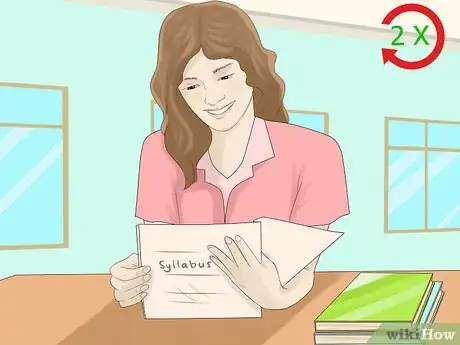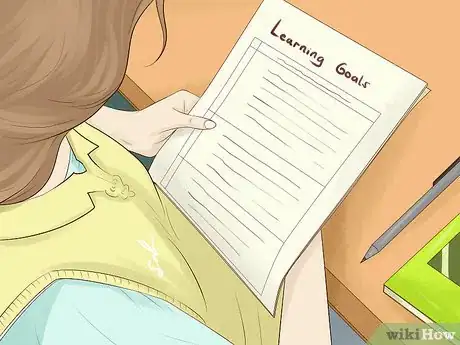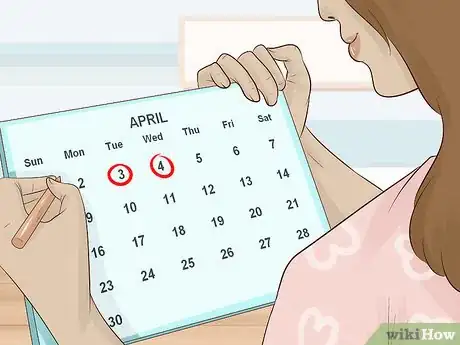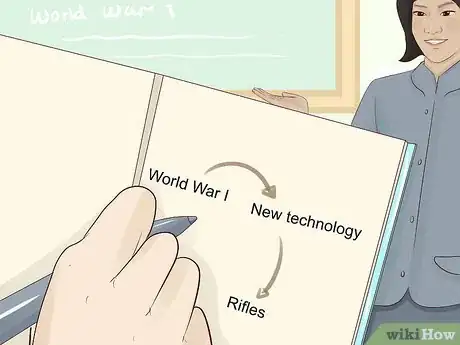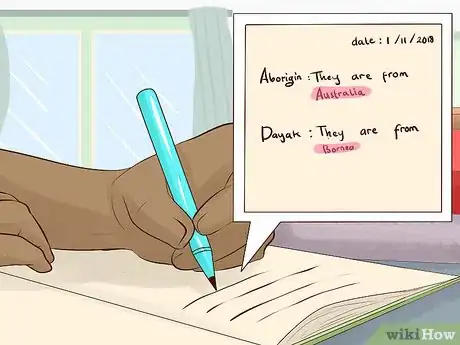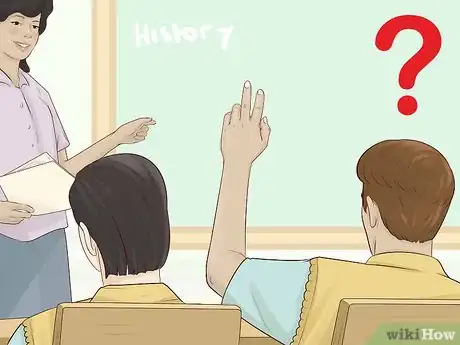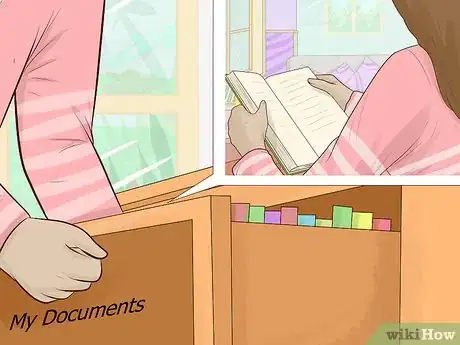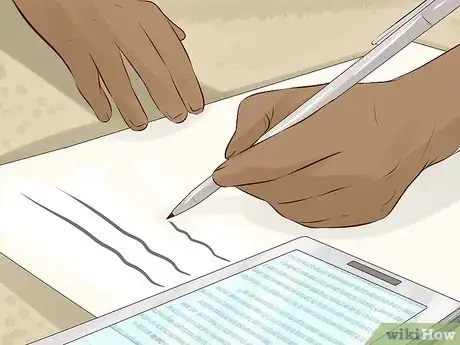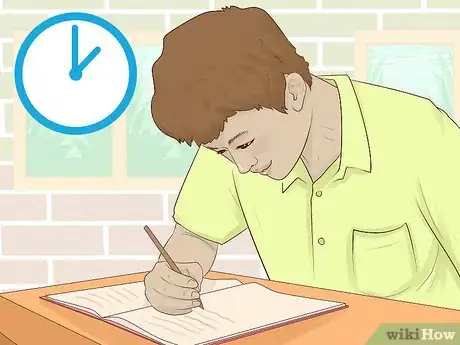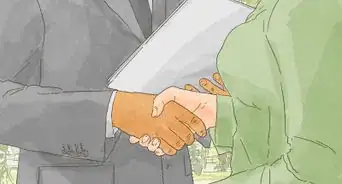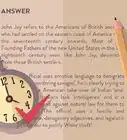This article was co-authored by Emily Listmann, MA and by wikiHow staff writer, Jessica Gibson. Emily Listmann is a private tutor in San Carlos, California. She has worked as a Social Studies Teacher, Curriculum Coordinator, and an SAT Prep Teacher. She received her MA in Education from the Stanford Graduate School of Education in 2014.
There are 10 references cited in this article, which can be found at the bottom of the page.
wikiHow marks an article as reader-approved once it receives enough positive feedback. In this case, several readers have written to tell us that this article was helpful to them, earning it our reader-approved status.
This article has been viewed 63,350 times.
If you think history is just about memorizing names and dates, you may be surprised at your teacher's expectations. Although many teachers want you to be familiar with key events, you'll also need to learn concepts and themes. This is one of the reasons it's important to take useful notes and review them before exams or essays are due. If you have any questions, always contact the teacher for additional help.
Steps
Recognizing Course Expectations
-
1Read the syllabus at least 2 to 3 times. The syllabus is one of the most important documents you'll read in your history course because it will tell you exactly what your teacher expects, the way the course will be graded, what assignments you'll need to complete, and the schedule for the term.[1]
- The syllabus will also give you the teacher's contact information and office location, school policies, and important dates for the term.
- For example, your syllabus might show that you'll need to write 2 essays, take 3 exams, and participate in a weekly discussion.
-
2Find the teacher's learning outcomes and goals for the class. Most teachers will list measurable learning outcomes on the syllabus and they'll talk about what historical topics will be covered in the course. These learning outcomes often become essay questions on exams or questions that you discuss in class.[2]
- For example, your teacher may ask you to describe how ideologies such as liberalism and nationalism shaped the 19th century. Then you might have to write an essay describing how these ideologies affected Europe.
Advertisement -
3Pay attention to the teacher's expectations. Since there are a number of teaching styles and history courses, listen to your teacher to figure out what they want you to get out of the course. For example, if you're taking a history of philosophy or revolution class, the teacher might care more about class discussion and essay assignments than rote memorization.[3]
- It's also important to ask your teacher questions to clarify content and their expectations.
- If you're taking a lower-level or introduction to history course, you'll probably be expected to learn key dates and names. The teacher should make it clear how they'll test this knowledge.
-
4Write important course dates on your calendar. Once you've learned about how the course will be structured, make notes of important dates in your calendar, journal, or phone. If you struggle with deadlines, set up an alert to remind you a few days in advance before a big exam or essay is due.[4]
- Give yourself time around big deadlines to focus on the history class. For example, if you have a presentation on primary documents coming up, either work on it gradually throughout the week or clear work for your other courses in the days before it's due.
-
5Review the feedback given by your instructor. When you get back your graded assignments, look back over them to see what you did correctly and where you struggled. If your instructor provided written comments, be sure to read them and ask for any necessary clarification. By going over these assignments, you can make sure you fully understand the class expectations so you can make any needed adjustments.
- This is especially helpful after tests! Once you know how your instructor formats their tests, you can create your study guide based off that format.
- When in doubt, always talk to your instructor. They'll be happy to help you understand what they expect from you.
-
6Get help if you feel like you're struggling at any point. Find out when your teacher has office hours or email them with any concerns you're having. Do this earlier in the term rather than later, since your teacher won't be able to devote as much time if most students wait until the last minute to get help.[5]
- If you're struggling with writing history essays, your teacher may be able to point out resources that are available to you at your school's writing center. Or if you're having difficulty understanding a primary source, they can talk to you about the context in which the source was made.
Taking Effective Notes
-
1Show up to every class. If you're tempted to miss class and ask a friend to take notes for you, the notes won't help you as much as if you were in class taking them. This is because everyone has a different note-taking strategy and you really have to listen to the context for the notes to make sense.[6]
- If you know you have to miss class, ensure that you do the assigned reading for that day and make an appointment to meet with the teacher about important themes or concepts that they covered.
-
2Listen for key concepts. Instead of writing down everything your teacher says, take the time to listen to their lecture. When they get to an important theme or event, make a note of it and remember to write down why it's important. This can help you when you use your notes for studying later.[7]
- For example, instead of just writing down "World War I -- new technology -- rifles" and hoping that you remember what made this notable, write a phrase such as, "New technologies (such as rifles, machine guns, gas) developed modern warfare and led to devastating loss of life."
-
3Take notes during films or class discussions. If your teacher chooses to show a clip or film, don't just sit back and tune out since they're showing it for a reason. Make a note about how the film relates to the class or highlights themes you covered. If you're having a weekly class discussion, write down some of the questions your teacher asked since these may show up on exams.[8]
- For example, if you watch "Dr. Strangelove" in class, be prepared to connect the film to the Cold War.
-
4Develop your own system for taking legible notes. Since there are so many different ways of taking notes, it's important to find a method that works for you. If you have a tried-and-true way of making notes, stick to it as long as they're easy to read.
- For example, if you abbreviate a lot when you make notes, ensure that you can remember the abbreviations.
- It's also a good idea to write down the date and/or title of the lecture so you can find it easily when you're studying later.
-
5Look over your notes for at least 10 minutes later in the day. It's easy to rush through notes, especially if your instructor covers a lot of information rather quickly. To ensure that you wrote down important themes or concepts, read your notes when you get home and take the time to fill in any blanks.[9]
- Do this the same day as the class so the information is fresh and you don't forget what you couldn't write down in class.
Fulfilling Course Requirements
-
1Ask questions and interact at weekly discussions. Even most large lecture-style history courses will expect you to meet with a small group every week. Weekly discussions are your way to ask questions about the material, give your insight, and make connections about the themes of the course.[10]
- For example, you might say, "Why were we assigned to discuss these political posters?" Then talk about how the posters illustrate popular viewpoints held by nations during war.
- Since many teachers will also grade participation, engaging during the weekly discussions may count for a portion of your overall class grade.
-
2Prepare to take exams and finals. If you've been following the class syllabus, you should know well in advance when a test or final is coming up. Budget your studying time so you can review your class notes and work on any study-guides your teacher may give you. Show up on time to the exam and give detailed answers that show the extent of your knowledge.[11]
- If the exam has short-answer questions or short essay questions, directly answer the question while connecting as many key concepts to the course as you can. Including details such as dates, treaties, or key people will strengthen your answer.
- Avoid cramming or trying to study a large portion of information the night before an exam or final. Instead, plan several short study sessions in the weeks leading up to the exam.
-
3Look over your assignments to monitor your progress in the class. Keep track of your grades to make sure you're on track to pass. More importantly, notice which topics you've mastered, as well as which topics have challenged you. You may be able to identify topics you don't need to keep studying, as well as topics you need to study more.
- Keep your old assignments in a folder in case you need to look back over them.
-
4Read primary documents and be prepared to explain them. If you're in an introduction to history course, your teacher will probably walk you through how to read a primary document for its importance and context. As you become more familiar with primary documents such as letters, speeches, and journal entries, make notes about how they fit into the themes of the course.[12]
- For example, if you're looking at a political cartoon of a New Woman published at the end of the 19th century, you could discuss the changes to society and the push for women's rights.
-
5Pull evidence from the sources you use to support your ideas. As you read through primary sources and other academic texts, underline important information and write notes in the margins or on notecards. When you write essays or answer test questions, it's important to use these quotes or supporting statements as evidence to back up your claims. Remember to cite your sources using your instructor's preferred style guide.
- Using evidence from your readings shows you have a good grasp on the information.
- For example, you might use quotes from personal letters written during the Civil War as evidence when describing the struggles soldiers faced during the war.
-
6Complete thoughtful essays on time. Most history courses will require at least a few essay assignments. Since you can usually select a specific topic to write about, choose something that interests you and answers the prompt. Include research that supports your argument and remember to turn the essay in on time.[13]
- For example, if you're writing about the effect of Westward Expansion on Native American communities, it's important to include documents or images created by the Native American communities as well as the settlers.
Community Q&A
-
QuestionI'm feeling overwhelmed in my history course because I'm taking my first history course as a junior in high school. How can I succeed in the class?
 Community AnswerAsk your teacher if you can meet to discuss your concerns. The teacher may be able to go over background detail in more depth so you have a better understanding of what's going on in the course. They may also be able to recommend resources (books, articles, documentaries) that can help bring you up to speed. Communicating with your teacher is important, so don't feel like you can't reach out with your concerns.
Community AnswerAsk your teacher if you can meet to discuss your concerns. The teacher may be able to go over background detail in more depth so you have a better understanding of what's going on in the course. They may also be able to recommend resources (books, articles, documentaries) that can help bring you up to speed. Communicating with your teacher is important, so don't feel like you can't reach out with your concerns. -
QuestionHow long are the essays usually?
 Community AnswerMost essays require about 5 paragraphs, but the length of your essay will depend on your course's requirements. You should talk to your teacher about this.
Community AnswerMost essays require about 5 paragraphs, but the length of your essay will depend on your course's requirements. You should talk to your teacher about this.
References
- ↑ https://chroniclevitae.com/news/1498-the-absolute-worst-way-to-start-the-semester
- ↑ https://www.gavilan.edu/research/spd/Writing-Measurable-Learning-Outcomes.pdf
- ↑ https://www.scholarships.com/resources/college-prep/college-classes/top-10-tips-for-passing-college-classes/
- ↑ http://open.lib.umn.edu/collegesuccess/chapter/2-3-organizing-your-time/
- ↑ https://www.scholarships.com/resources/college-prep/college-classes/top-10-tips-for-passing-college-classes/
- ↑ https://www.scholarships.com/resources/college-prep/college-classes/top-10-tips-for-passing-college-classes/
- ↑ http://www.historyguide.org/guide/notes1.html
- ↑ http://www.historyguide.org/guide/notes1.html
- ↑ https://clas.uiowa.edu/history/teaching-and-writing-center/guides/taking-lecture-notes
- ↑ https://teachinghistory.org/teaching-materials/teaching-guides/25620
- ↑ https://clas.uiowa.edu/history/teaching-and-writing-center/guides/taking-exams
- ↑ https://www.wm.edu/as/history/undergraduateprogram/hwrc/handouts/primarysources/index.php
- ↑ https://clas.uiowa.edu/history/teaching-and-writing-center/guides/final-checklist
- ↑ http://open.lib.umn.edu/collegesuccess/chapter/2-3-organizing-your-time/
